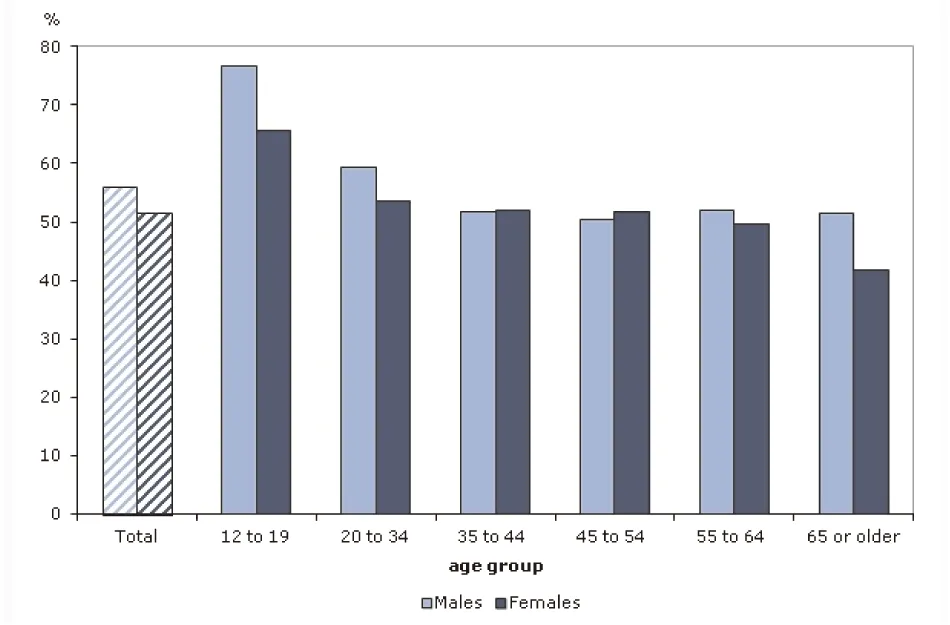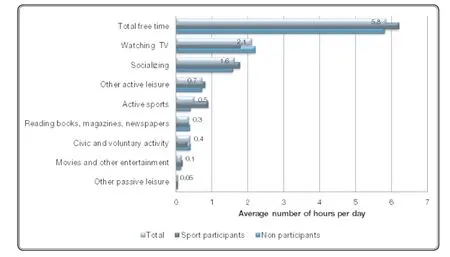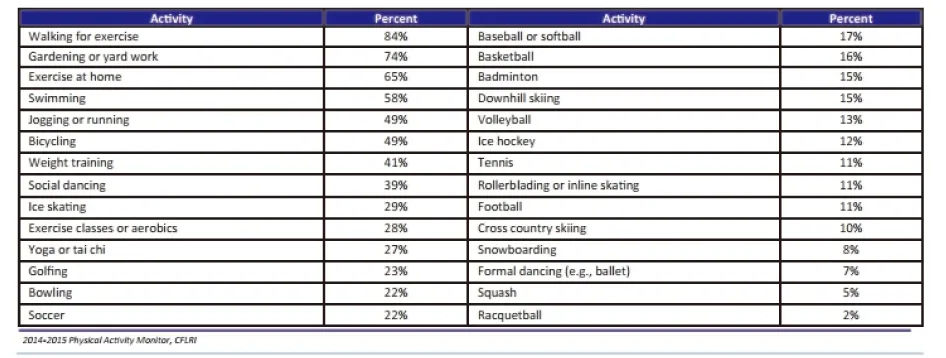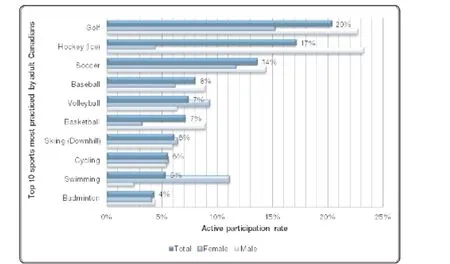Current Trends in Leisure Sports in Canada
2017-07-24KarenDanylchuk
ThepurposeofthisstudywastoexplorethecurrenttrendsinleisuresportsinCanada.BasedonphysicalactivityandsportparticipationlevelsinvestigationconductedbyStatisticsCanadaandtheCanadianFitnessandLifestyleResearchInstitute,thispaperprovidedanoverviewofthemostrecentfindingsonparticipationofleisure,sport,physicalactivity,andexerciseofCanadians.
Canadianleisuresports;physicalactive;sportparticipation
In many countries around the world, it is common practice to periodically investigate physical activity and sport participation levels of its citizens. Canada is no exception to this practice and carries out regular assessments through organizations such as Statistics Canada and the Canadian Fitness and Lifestyle Research Institute. This paper will provide an overview of the most recent findings from three of these assessments: (a) a Canadian Community Health Survey conducted in 2012, (b) a Sport Participation paper published in 2013 that was based on a 2010 survey, and (c) the Canadian Fitness and Lifestyle Research Institute survey in 2014-15.
Prior to discussing the results of these surveys, however, it is important to articulate the meaning of leisure, sport, physical activity, and exercise as defined by the organizations conducting the surveys. A generally widely accepted definition of leisure is any activity that is non-paid work or studies. According to Statistics Canada (2013), it may include cultural activities (e.g., reading, going to or watching movies; listening to music; attending theatre or musical performances; visiting museums, art galleries, aquariums, parks, gardens, historic sites), as well as sports participation, physical activity, and exercise.
Sport, as defined by Sport Canada (2013), is an activity that has several characteristics: (a)involves two or more participants who engage for the purpose of competitively evaluating their personal performance, (b) involves formal rules and procedures, (c) requires tactics and strategies,(d) requires specialized neuromuscular skills which can be taught and learned, (e) involves a high degree of difficulty, risk, or effort in reproduction of movement or form, (f) its competitive mode implies the development of trained coaching personnel, (g) its primary activity involves physical interaction of the participant with the environment, and (h) does not involve activities in which the performance of a motorized vehicle is the primary determinant of the competitive outcome, but where mechanized vehicles or conveyance are used, the activity must entail significant physical effort in propelling the vehicle or conveyance. Based on this definition, several physical and leisure activities are excluded, such as non-competitive aerobics, aquafit, bicycling for recreation or transportation only, body building or body sculpting, car racing, dancing, fishing, fitness classes, hiking, jogging lifting weights, motorcycling, snowmobiling, and non competitive walking.
Physical activityis defined by the World Health Organization (2017) as any bodily movement produced by skeletal muscles that requires energy expenditure, including activities undertaken while working, playing, carrying out household chores, travelling, and engaging in recreational pursuits.
Exercise is a subcategory of physical activity that is planned, structured, repetitive, and aims toimprove or maintain one or more components of physical fitness. Beyond exercise, any other physical activity that is done during leisure time, for transport to get to and from places, or as part of a person’s work, has a health benefit.
According to Statistics Canada, in 2012, 53.9% (15.6 million) of Canadians aged 12 and older reported they were at least moderately active during their leisure time, excluding energy expended at work, in transportation, or doing housework. “Moderately active” is defined as being equivalent to walking at least 30 minutes a day or taking an hour-long exercise class at least three times a week. There has been a slight increase in Canadian participation in active leisure from 2001 to 2012, and males were more likely than females to be at least moderately active in leisure time. As well, 56.2% of males in 2012 were moderately active compared to 51.6% of females in 2012, up from previous years.
As noted in Figure 1, Canadians aged 12 to 19 had the highest rate of being at least moderately active in leisure time—76.7% for males and 65.6% for females in this age group.
As in previous years when the Sport Participation survey was conducted, Figure 2 (Sport Participation, 2013) shows that walking or jogging was found to the most common active leisure activity among Canadians, with 12% walking or jogging on a given day in 2010 compared to 10% in 1992. Exercising (e.g., yoga, weight lifting aerobics) was the second most popular active leisure activity, followed by participation in sports, outdoor activities, and cycling.

Source:Canadian Community Health survey,2012
Figurc 1 Percentage physicaly active or moderately active in leisure time, by age group and sex,household population aged 2 or older, Canada,2012

Figure 2 Changes in active leisure participation of Canadians on a given day from 1992 to 2010
Figure 3 (Sport Participation, 2013) depicts that non-participants, referring to those who do not regularly practice sport, participate in active leisure for an average of one hour and 6 minutes per day compared to an average of one hour 32 minutes for sport participants.

Figure 3 Average time per day spent on activities
In a more recent report conducted by the Canadian Fitness and Lifestyle Research Institute, the 2014-15 Physical Activity Monitor asked Canadians about the type of physical activities that they participated in during the 12 months prior to the survey: the majority of Canadians (18 years and older) indicated that they participated in walking for exercise (84%), gardening or yard work (74%), exercise at home (65%), and swimming (58%).
Table 1 Popular activities by gender (18 years and older)

Table 1 depicts the proportion of these activities by gender, whereas Figure 4 depicts the popularity of these activities by age. Walking remains the most popular activity among adults of all ages. The proportion of adults participating in bicycling, swimming, weight training, skating, roller blading, jogging or running, home exercise, downhill skiing, snowboarding, bowling, and social dance, and team sports such as volleyball, basketball, soccer, ice hockey, baseball or softball, or football, and racquet sports generally decreases with increasing age. Younger adults (18 to 24 years), in contrast, are least likely to indicate that they garden or do yard work.
Finally, Figure 5 depicts sport participation by sex in 2010 (Sport Participation, 2013). Golf, the overall most popular sport among sport participants, had a higher participation rate among men than women. The three most popular sports among men were ice hockey, golf, and soccer, whereas for women it was golf, soccer, and swimming.
凯伦·丹尼贾克,世界休闲体育协会副主席,加拿大伟斯顿大学运动与健康学院副院长,教授,世界运动管理学会联合会主席。
Western University, Canada 伟斯顿大学,加拿大
2017-04-16
2017-05-09
Current Trends in Leisure Sports in Canada
Karen Danylchuk

Figure 4 Popular activities by age (18 years and older)

Figures 5 Participation rate for the top ten sports among sport participants by sex,2010
